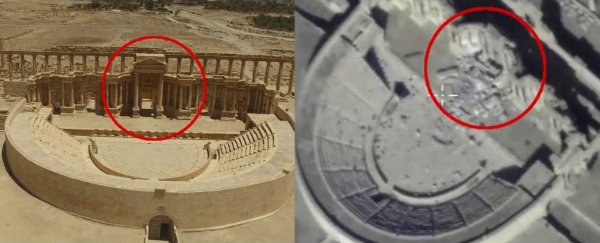Drone footage released by the Russian Ministry of Defense this week has revealed further destruction by ISIS militants in the ancient city of Palmyra in Syria - one of the Middle East's most famous Roman sites.
Decried as a "war crime" due to the site's World Heritage listing, Palmyra's famous Roman amphitheatre now lies in ruins, and most of its Tetrapylon - a unique monument of 16 columns, part of which dated to more than 1,700 years ago - has been flattened.
The Russian drone footage contrasts images taken before and after the Islamic State's most recent offensive in the ancient city.
Back in May 2015, ISIS militants managed to overrun Palmyra, and held it for almost 12 months, during which time they deliberately destroyed a number of the city's ancient monuments.
In March 2016, Syrian and Russian forces drove them out, but could only hold the city until late last year, when news of a renewed ISIS offensive came soon after reports that militants had bulldozed two of the world's most important ancient cites nearby - Dur-Sharrukin and Nimrud.
Now, the grand facade of the Roman amphitheatre lies in ruins, and just two of the Tetrapylon's 16 columns remain standing:
The footage provides a clearer picture of what was revealed in grainy satellite imagery released by a Palmyan local last month, and confirmed by the Syrian state officials:
Close up of the recent destruction of the Tetrapylon and Roman Theatre at #Palmyra by ISIS (fixed dates) pic.twitter.com/4w3nUGadCg
— @eliothiggins.bsky.social (@EliotHiggins) January 20, 2017
"Activist Khaled al-Homsi, who is from Palmyra, shared satellite imagery to Twitter, which appears to confirm the scale of the damage," Alison Meuse reported for NPR back in January.
"The face of the Roman theatre is a pile of rubble and only four of the Tetrapylon's 16 columns appear to be standing."
Just to give you an idea of how incredible these structures were - and how important they were to the local culture - check out the picture below from March 2016.
One of Russia's oldest orchestras, the Mariinsky Orchestra, performed in the amphitheatre to commemorate the end of ISIS's first offensive in the city:
And here's the Tetrapylon before it was destroyed, marking the intersection of Palmyra's two main boulevards with four sets of columned structures:
 Abdulhadi Najjar/Wikimedia
Abdulhadi Najjar/Wikimedia
While most of the columns were modern replicas, one was original, dated to the 3rd century AD - more than 1,700 years ago.
The head of UNESCO, Irina Bokova, has characterised the deliberate destruction of Palmyra as a "war crime".
"This is not just the destruction of ancient ruins, this is the destruction of civilisation," Maamoun Abdulkarim, Syria's antiquities minister, said last month.
Palmyra isn't just an important ancient city to the Syrian locals - it's the site of some of the world's most important archaeological sites, earning it the reputation of being the 'Pearl of the Desert'.
One of its most interesting moments in history was back in the 3rd century, when the legendary Queen Zenobia ruled over the city when it was flush with limestone and dolomite.
Often described as Palmyra's "warrior queen", Zenobia was Palmyrian-born, and became known for her military prowess and defiance of the Roman Empire.
 "Queen Zenobia's Last Look Upon Palmyra" by Herbert Schmalz
"Queen Zenobia's Last Look Upon Palmyra" by Herbert Schmalz
Within a few years of her rule, she had gained control of almost a third of the Roman Empire's land, including some of its most valuable territories - Egypt and modern Turkey.
"She was beautiful and highly educated, and made herself a ruler in the very masculine world of the Arabian desert," Richard Stoneman, professor of classics and ancient history at the University of Exeter in the UK, told the Huffington Post.
"She took on the might of Rome, the world's greatest empire, and nearly succeeded in creating a breakaway state."
While we can only hope that Palmyra's remaining monuments are left intact, at least we'll always have the storied history wrapped up in the architecture for generations to come.
